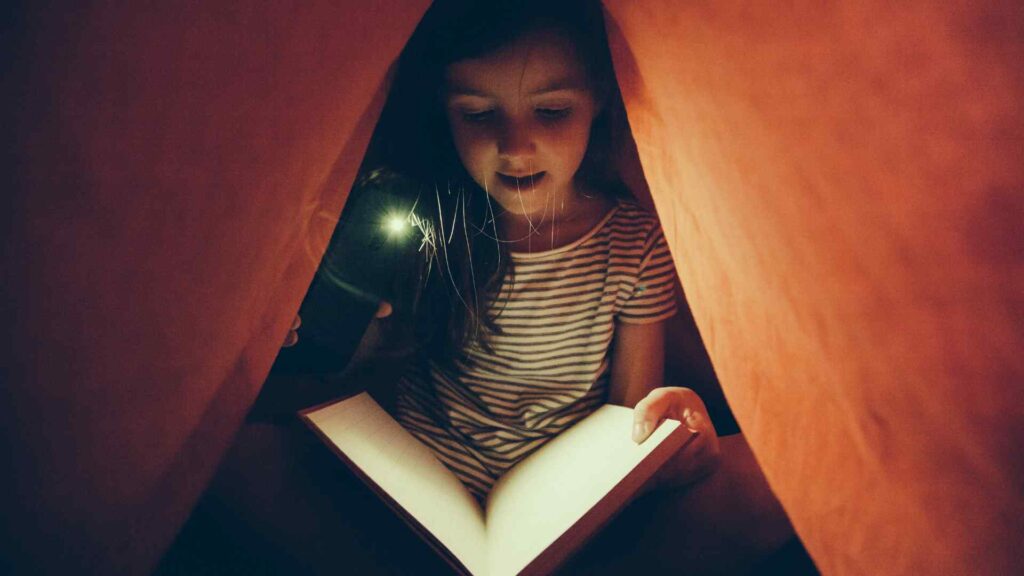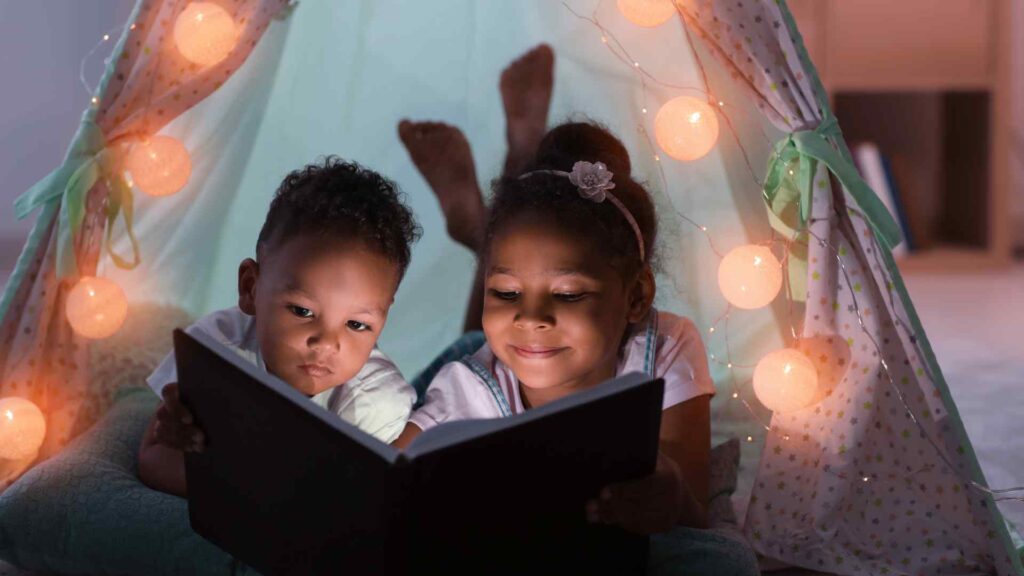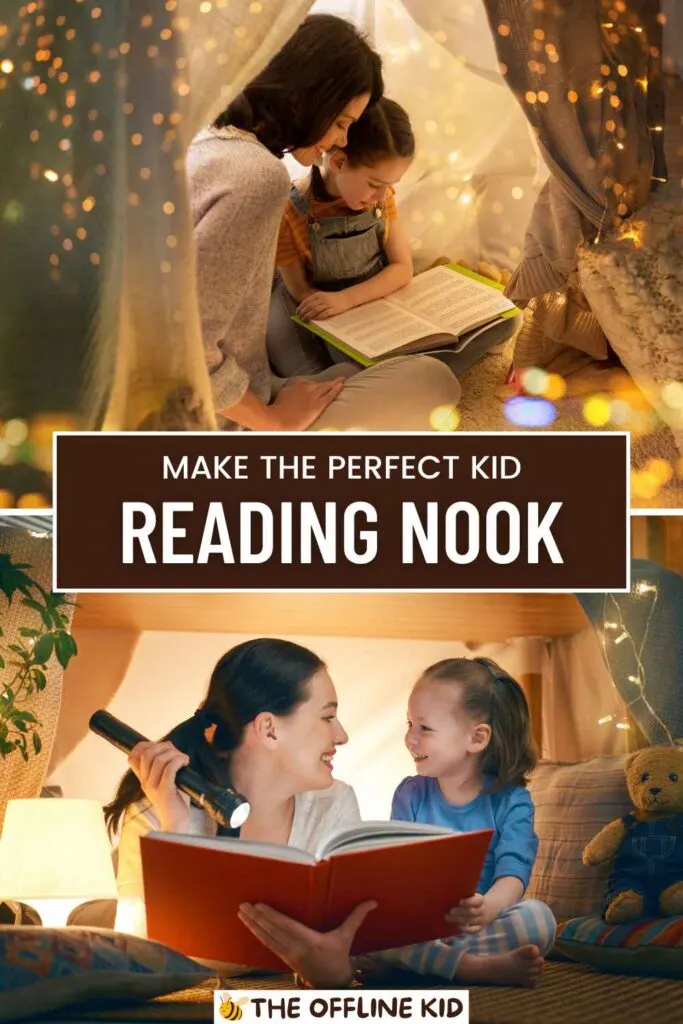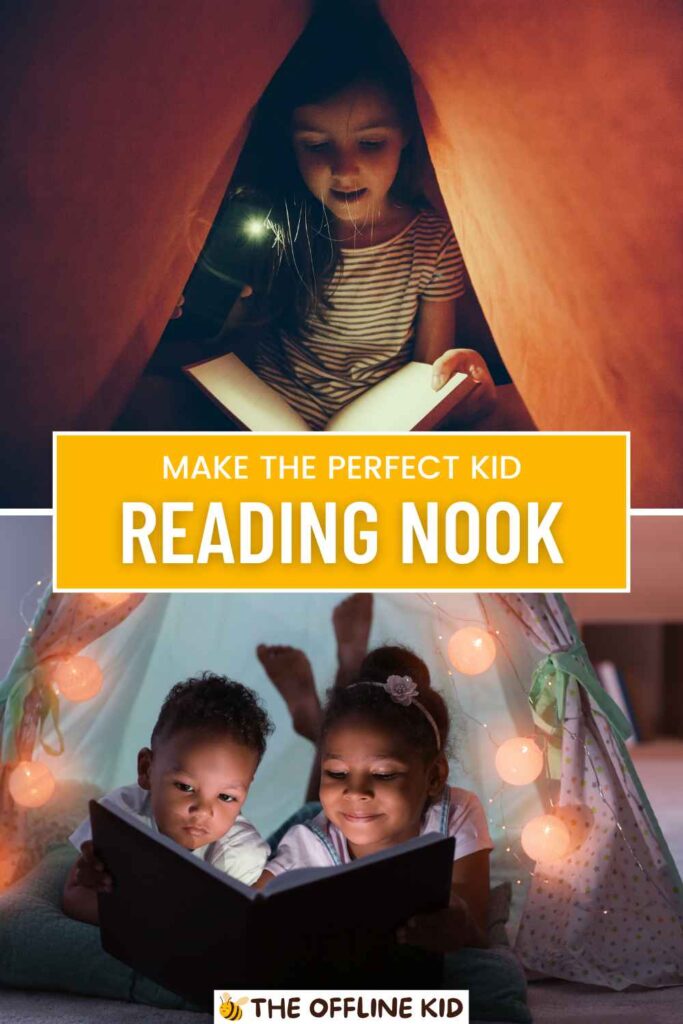Creating a cozy reading nook for your child can ignite their love for books and provide a peaceful retreat.
This guide will help you design a perfect reading space that is comfortable, inviting, and inspiring for young readers.
Choosing the Right Location
Finding the perfect spot for your child’s reading nook is the first step in creating an inviting and functional space.
The location should be quiet, accessible, and well-lit to encourage frequent use.
Finding a Quiet Spot
- Minimize Distractions: Choose a location away from high-traffic areas and noisy parts of the house. A quiet corner in the living room, a spot in your child’s bedroom, or a cozy area under the stairs can work well.
- Soundproofing Tips: Use heavy curtains, rugs, and soft furnishings to help dampen noise. Adding a white noise machine can also create a more peaceful environment.
Considering Natural Light and Accessibility
- Natural Light: Position the nook near a window to take advantage of natural light. This not only makes the space brighter but also creates a pleasant atmosphere for reading.
- Accessibility: Ensure the reading nook is easily accessible to your child. Avoid placing it in hard-to-reach areas or spots that are difficult for them to get to on their own.
Space-Saving Options for Small Homes
- Compact Furniture: Opt for furniture that fits well in smaller spaces. Foldable chairs, stackable cushions, and wall-mounted shelves are great options.
- Multi-Functional Spaces: Consider creating a dual-purpose area. A corner of the bedroom, a part of the playroom, or even a transformed closet can serve as an excellent reading nook.
By carefully choosing the location, you set the foundation for a reading nook that your child will love to spend time in.

Designing for Comfort
Creating a comfortable space is key to making a reading nook inviting and enjoyable for your child.
Focus on seating, soft textiles, and a cozy atmosphere to ensure they love spending time in their nook.
Importance of Comfortable Seating
- Ergonomic Options: Choose seating that supports your child’s posture and comfort. Ergonomic chairs or cushions can prevent discomfort during long reading sessions.
- Variety of Seating: Provide options like bean bags, small armchairs, floor cushions, or even a hammock chair. This allows your child to choose what feels best for them.
Types of Seating
- Bean Bags: Soft and moldable, bean bags conform to the body and are easy to move around.
- Floor Cushions: Large floor cushions are versatile and can be stacked or spread out for different seating arrangements.
- Small Armchairs: Child-sized armchairs offer a more structured seating option that still feels cozy.
Adding Soft Textiles
- Blankets: A few soft, cozy blankets can add warmth and comfort. Opt for materials like fleece or plush for a snuggly feel.
- Pillows: Decorative pillows in various shapes and sizes can make the nook more inviting and provide additional support.
- Rugs: A soft rug can define the space and add a layer of comfort, especially if the nook is set up on a hard floor.
Creating a Cozy Atmosphere
- Warm Colors: Use warm, inviting colors to make the space feel cozy. Soft pastels, warm neutrals, or your child’s favorite colors can make a big difference.
- Textures and Layers: Layer different textures and materials to create a rich, inviting space. Think about mixing soft fabrics with natural materials like wood or woven baskets.
- Personal Touches: Add items that reflect your child’s personality and interests. Personalized name plaques, DIY crafts, or favorite toys can make the nook feel uniquely theirs.
By focusing on comfort, you’ll create a reading nook that not only looks appealing but also feels like a perfect place for your child to relax and immerse themselves in their favorite books.
Creating an Inviting Atmosphere
An inviting atmosphere in your child’s reading nook can make it a magical place they’ll love to visit.
By incorporating colors, themes, and personal touches, you can create a space that is both visually appealing and emotionally comforting.
Using Colors and Themes
- Color Schemes: Choose a color palette that is calming and conducive to relaxation. Soft blues, greens, and neutrals can create a serene environment. Bright and cheerful colors can also be used to make the space feel lively and fun.
- Themes: Consider incorporating a theme that aligns with your child’s interests. Whether it’s a fairy tale forest, outer space, jungle adventure, or a cozy cabin, a theme can add a sense of wonder and excitement to the reading nook.
Personalized Touches
- Name Plaques: Personalize the space with your child’s name. Custom name plaques or signs can make the nook feel special and uniquely theirs.
- DIY Crafts: Involve your child in creating decorations for the nook. DIY crafts like painted frames, handmade garlands, or decorated jars can add a personal touch and make the space more meaningful.
- Favorite Characters or Interests: Incorporate elements that reflect your child’s favorite characters, hobbies, or interests. Posters, stuffed animals, or themed pillows can make the nook feel familiar and comforting.
Incorporating Favorite Characters or Interests
- Character Decor: Use decorations featuring beloved book or movie characters. This can include wall decals, posters, or themed cushions.
- Interest-Based Items: If your child loves nature, include elements like plants, animal prints, or nature-themed books. For a budding astronaut, add space posters, starry lights, or a telescope.
Creating a Cozy Vibe
- Lighting: Use soft, warm lighting to create a cozy atmosphere. String lights, fairy lights, or a gentle nightlight can add a magical glow.
- Textures: Incorporate a variety of textures to make the space feel rich and inviting. Think about mixing soft fabrics, smooth wood, and plush rugs.
- Quiet Corners: Create a sense of enclosure and privacy with canopies, curtains, or a small tent. This can make the nook feel like a secret hideaway.
Incorporating Interactive Elements
- Interactive Decor: Add elements like a chalkboard wall, magnetic letters, or an interactive globe to engage your child’s curiosity and learning.
- Sensory Items: Include sensory-friendly items like textured pillows, fidget toys, or a sensory bin to make the space more inclusive and engaging.
By carefully curating the atmosphere of the reading nook, you can create a space that is not only visually appealing but also emotionally inviting, making it a perfect retreat for your child to dive into their favorite stories.

Lighting Considerations
Proper lighting is essential for creating a comfortable and enjoyable reading nook. It not only enhances the ambiance but also ensures that your child can read without straining their eyes.
Here are some tips on how to achieve the best lighting for your child’s reading space.
Natural Light vs. Artificial Light
- Natural Light: Utilize natural light as much as possible. Position the reading nook near a window to benefit from daylight. Natural light is easier on the eyes and can make the space feel more open and inviting.
- Artificial Light: Supplement natural light with artificial lighting, especially for evening reading or during darker months. The key is to find a balance that provides adequate illumination without being too harsh.
Types of Lighting
- Floor Lamps: Tall floor lamps can provide broad, even lighting for the entire nook. Look for lamps with adjustable heads so you can direct the light where it’s needed.
- String Lights: String lights add a whimsical touch and create a cozy atmosphere. They’re perfect for wrapping around a canopy or draping along shelves.
- Reading Lamps: A dedicated reading lamp with a flexible neck can be positioned to shine directly on the book, providing focused light without glare. Choose lamps with adjustable brightness levels to suit different times of the day.
Ensuring Adequate Lighting Without Strain
- Soft White Bulbs: Use soft white bulbs (around 2700K-3000K) to create a warm and comfortable glow. These bulbs mimic natural light and reduce eye strain.
- Positioning: Place lamps and lights in a way that eliminates shadows on the book pages. The light should come from behind or beside the reader, not directly overhead or in front.
- Dimming Options: Install dimmer switches or use lamps with multiple brightness settings. This allows you to adjust the lighting to suit different activities, such as reading, playing, or winding down before bed.
Fun and Creative Lighting Ideas
- Fairy Lights: Add a magical touch with fairy lights. They’re perfect for creating a dreamy atmosphere and can be arranged in various patterns or shapes.
- Glow-in-the-Dark Stars: Decorate the ceiling with glow-in-the-dark stars to add an enchanting element that kids will love, especially at bedtime.
- Themed Lamps: Choose lamps that match the theme of the reading nook. Animal-shaped lamps, rocket lamps, or lantern-style lights can enhance the overall decor and make the space more fun.
Safety Considerations
- Child-Friendly Fixtures: Ensure all lighting fixtures are safe and child-friendly. Avoid lamps with exposed bulbs or parts that can get very hot.
- Stable Placement: Place lamps in stable, secure locations to prevent them from tipping over. Wall-mounted lights can be a safer option for younger children.
- Cord Management: Keep cords organized and out of reach. Use cord clips or covers to prevent tripping hazards and keep the space tidy.
By carefully planning the lighting in your child’s reading nook, you can create a space that is not only cozy and inviting but also practical and safe for their reading adventures.

Organizing Books
A well-organized book collection makes the reading nook more inviting and encourages your child to explore different stories.
Here are some tips on how to effectively organize and display books in your child’s reading nook.
Choosing Bookshelves and Storage Options
- Low Shelves: Opt for low, accessible bookshelves that allow your child to easily reach and choose their own books. This fosters independence and encourages regular reading.
- Wall-Mounted Shelves: Wall-mounted shelves are a great space-saving option and can be arranged in creative patterns. They keep the floor space clear and add visual interest.
- Book Bins and Baskets: Use bins and baskets for book storage. They are easy to move around and can be organized by theme or genre. Plus, they add a casual, relaxed feel to the nook.
Displaying Books Attractively
- Front-Facing Display: Display some books with their covers facing outward. This makes it easier for younger children to choose books based on the cover art and can entice them to read new stories.
- Rotating Books: Regularly rotate the books on display to keep the selection fresh and interesting. Highlight seasonal books or new additions to the collection.
- Themed Displays: Create themed displays that tie into holidays, seasons, or your child’s current interests. This can make the nook more engaging and fun.
Categorizing Books
- By Genre: Organize books by genre, such as fiction, non-fiction, fantasy, and science. This helps your child develop an understanding of different types of stories and subjects.
- By Reading Level: Arrange books by reading level to ensure your child can easily find books that are appropriate for their skill level. This can also help with tracking their reading progress.
- By Author or Series: Group books by the same author or within the same series together. This makes it easier for your child to find their favorite stories and discover more books by beloved authors.
Creating a Reading Routine
- Daily Reading Time: Establish a daily reading routine where your child spends time in their reading nook. Consistency helps build a habit and makes reading a cherished part of their day.
- Reading Challenges: Introduce reading challenges or goals, such as reading a certain number of books per month. Rewarding achievements can motivate your child to read more.
- Family Reading Sessions: Schedule family reading sessions where everyone reads together. This can be a bonding time and show your child that reading is a valued activity.
Involving Your Child in Organization
- Let Them Help: Involve your child in organizing their books. Let them decide where to place their favorites and how to arrange their collection. This gives them a sense of ownership and pride in their reading nook.
- Labeling: Use labels to help keep the books organized. Picture labels can be helpful for younger children who can’t read yet. Older children can help create and place the labels.
Maintaining the Book Collection
- Regular Clean-Up: Encourage your child to keep their reading nook tidy. A quick daily clean-up can keep the space organized and inviting.
- Book Care Tips: Teach your child how to care for their books, such as handling them gently and storing them properly. This helps prolong the life of the books and keeps the collection in good condition.
- Library Visits: Make regular visits to the library to borrow new books. This keeps the collection dynamic and introduces your child to a wider range of stories and authors.
By organizing the books effectively and involving your child in the process, you can create a reading nook that is not only functional but also a source of joy and inspiration for your young reader.

Adding Fun and Interactive Elements
Incorporating fun and interactive elements into your child’s reading nook can make the space more engaging and enjoyable.
These additions can stimulate their imagination, provide sensory experiences, and encourage them to spend more time reading and exploring.
Including Toys and Stuffed Animals
- Favorite Plush Toys: Add a few of your child’s favorite stuffed animals to the reading nook. They can provide comfort and make the space feel more personal.
- Reading Companions: Create a small collection of “reading buddies” – toys that are specifically for the reading nook. These can become special companions during reading time.
Creating a Sensory-Friendly Space
- Textured Items: Incorporate items with different textures, such as fluffy pillows, knitted blankets, or smooth wooden toys. These can provide a tactile experience that enhances the cozy feel of the nook.
- Calming Tools: Add sensory tools like stress balls, fidget toys, or a small sand tray. These items can help your child relax and focus on their reading.
Adding a Small Table or Desk
- Multifunctional Furniture: Include a small table or desk where your child can draw, write, or do crafts. This adds versatility to the reading nook and encourages creative activities.
- Storage Solutions: Choose a table or desk with built-in storage for art supplies, notebooks, or small toys. This keeps the area organized and makes it easy for your child to switch between activities.
Incorporating Educational Elements
- Learning Materials: Add educational items like maps, globes, or alphabet charts. These can spark curiosity and make the nook a place for both reading and learning.
- Variety of Book Genres: Ensure the book collection includes a variety of genres, such as fiction, non-fiction, poetry, and educational books. This exposes your child to different types of content and keeps their interest piqued.
- Journaling and Creative Writing: Encourage journaling and creative writing by providing notebooks and writing tools. This can help develop your child’s writing skills and allow them to express their thoughts and creativity.
Creating Interactive Decor
- Chalkboard Wall: Paint a section of the wall with chalkboard paint. Your child can use this space to draw, write notes, or keep track of their reading list.
- Magnetic Letters: Install a magnetic board with letters and numbers. This can be a fun way for your child to practice spelling and math skills.
- Interactive Globe: A globe with interactive features, like lights or pop-up landmarks, can make learning about geography exciting and fun.
Adding Cozy Corners
- Hideaway Spaces: Create small hideaway spaces with canopies, tents, or curtain enclosures. These can make the reading nook feel like a secret hideout and add a sense of adventure.
- Reading Fort: Build a reading fort with blankets and pillows. This can be a fun project to do together and provide a cozy, enclosed space for reading.
Involving Your Child in the Decoration
- DIY Projects: Involve your child in decorating the reading nook with DIY projects. They can create artwork, make garlands, or personalize storage boxes. This can make the nook feel more special and meaningful.
- Personalized Touches: Add personal touches that reflect your child’s interests and personality. Whether it’s posters of their favorite characters, hand-painted signs, or collections of their artwork, these elements can make the nook uniquely theirs.
By adding fun and interactive elements, you can transform the reading nook into a dynamic and engaging space that your child will love to spend time in. These additions not only enhance the reading experience but also encourage creativity, learning, and relaxation.
Incorporating Educational Elements
A reading nook can be more than just a cozy space; it can also be a hub for learning and exploration.
By integrating educational elements, you can encourage your child’s curiosity and make their reading nook a place for both relaxation and discovery.
Adding Learning Materials
- Maps and Globes: Include maps or a globe to help your child learn about geography. Interactive globes with lights or pop-up landmarks can make learning about the world fun and engaging.
- Educational Posters: Hang posters that cover a variety of educational topics, such as the solar system, the alphabet, or animal species. These visual aids can stimulate interest and provide quick reference points for learning.
- Flashcards and Educational Games: Keep a set of flashcards or educational games within reach. These can be used for quick learning sessions or as a fun break from reading.
Including a Variety of Book Genres
- Fiction and Non-Fiction: Ensure the book collection includes both fiction and non-fiction books. Fiction can spark imagination and creativity, while non-fiction can provide valuable knowledge and insights.
- Poetry and Plays: Introduce your child to different literary forms by including poetry books and plays. These can enhance their understanding of language and literature.
- Biographies and Historical Books: Add biographies of inspiring figures and historical books. These can teach valuable life lessons and offer a deeper understanding of history and culture.
Encouraging Journaling and Creative Writing
- Notebooks and Journals: Provide notebooks and journals for your child to jot down their thoughts, write stories, or keep a reading log. This encourages writing practice and self-expression.
- Writing Tools: Stock the nook with a variety of writing tools, such as pencils, colored pens, and markers. Having these readily available can make writing activities more appealing.
- Prompts and Inspiration: Use writing prompts or inspirational quotes to spark your child’s creativity. These can be displayed on a bulletin board or written in a dedicated journal.
Incorporating Technology Wisely
- Educational Apps: If you choose to include a tablet or e-reader, load it with educational apps and e-books. Ensure screen time is balanced with traditional reading and other activities.
- Audio Books: Introduce audio books as an alternative way to enjoy stories. This can be particularly helpful for young readers or those with visual impairments.
- Interactive Learning Tools: Consider interactive learning tools like LeapFrog or similar devices that combine play with education.
Creating a Space for Hands-On Learning
- Craft Supplies: Keep a selection of craft supplies in the reading nook. Items like crayons, scissors, glue, and paper can be used for creative projects that tie into the books your child is reading.
- Science Kits: Include simple science kits or experiment books. These can make learning about science fun and interactive.
- Puzzle and Activity Books: Add puzzle and activity books to challenge your child’s mind and keep them engaged.
Encouraging Exploration and Curiosity
- Curiosity Corner: Dedicate a small area to a “Curiosity Corner” with rotating items of interest. This could include rocks, shells, magnifying glasses, or other objects that spark curiosity.
- Thematic Learning: Create thematic learning experiences by tying books and activities to specific themes, such as space exploration, dinosaurs, or the ocean.
- Field Guides: Provide field guides on topics like birds, insects, or plants. These can encourage outdoor exploration and a deeper connection with nature.
By incorporating educational elements into your child’s reading nook, you create a space that fosters a love of learning and discovery. This approach not only supports their academic growth but also nurtures their natural curiosity and creativity.


